Please Take Note: This is a review of the final game, but it might change slightly based on the success of the Kickstarter campaign. The game is being reviewed on the components and the rules provided with the understanding that “what you see is not what you might get” when the game is published. If you like what you read and want to learn more, we encourage you to visit the game’s website. Now that we have all that disclaimer junk out of the way, on with the review.
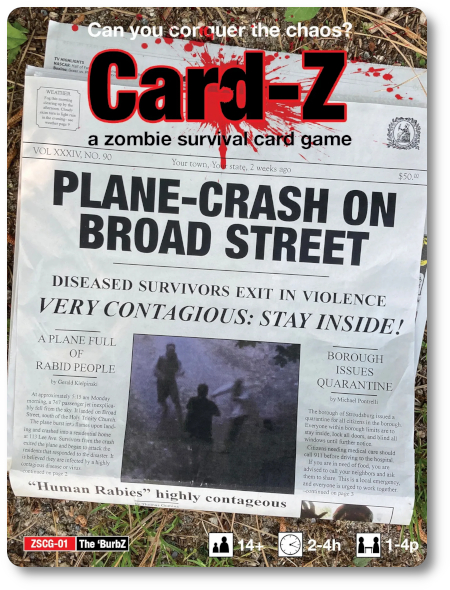
The Basics:
- For ages 14 and up
- For 1 to 4 players
- Approximately 180 minutes
Geek Skills:
- Active Listening & Communication
- Counting & Math
- Logical & Critical Decision Making
- Reading
- Strategy & Tactics
- Risk vs. Reward
- Visuospatial Skills
- Cooperative & Team Play
- Hand/Resource Management
Learning Curve:
- Child – Hard
- Adult – Moderate
Endorsements:
- Gamer Geek rejected!
- Parent Geek rejected!
- Child Geek rejected!
Overview
Welcome to the world of Card-Z. A gritty zombie survival game set in a suburban neighborhood. You must maneuver through the zombie apocalypse to survive. But be careful. One bite and you’re infected. Can you conquer the chaos and avoid a fate worse than death?
Card-Z, designed by Gerald Kielpinski and to be published by MantiGames, will reportedly be comprised of 256 cards (representing everything from time in the game, characters to interact with, various wounds, locations to visit, weather conditions, random encounters, enemies, loot, and foodstuffs), 25 Card clips (which is used as a counter on the cards), five standard six-sided dice (in the colors white and red), three standard ten-sided dice (in the colors green, red, and yellow), 12 pawns, 36 meeples, 14 meeple bases, 12 standard Poker chips, four Player mats, and one Battlefield map. As this is a review of a prepublished game, I cannot comment on the game component quality.
Determining Your Zombie Experience
Card-Z is scenario-driven, meaning that game set up is heavily dependent on what type of game the players are looking for. Scenarios available per our game are summarized here:
Solitaire:
- Training Mission One: The goal is to take one character and successfully deliver a roll of toilet paper to a set location.
- Training Mission Two: The goal is to take two Characters and rescue a group of dependents at a remote location, bringing them back successfully to base.
Cooperative:
- Civic Duty: The goal is to take two Characters per player and destroy all the zombies in the neighborhood, making the streets of your quiet burb safe to live in again.
Competitive:
- Pub Run: The goal is to take a set number of characters and clear out the Pub location for the rest of your friends to enjoy.
- Everyone for Themselves: Every player starts with one character, and the winner is the first who can obtain a set condition.
The rulebook goes into detail about how to set up the game using the different scenarios as guides. Due to the level of detail for each, we will not summarize them here as that would take up a significant amount of time. The full rules of the game can be obtained from the game’s website.
Let’s get into what is the most important thing: zombie killing. Grab your random characters and get going.

Your Daily Routine in Undead Hell
Regardless of what game type and scenario you elect to play, each game follows the same turn order, which we summarize here.
Action Phases: Dawn, Day, and Night
While we list this as one action phase for the sake of keeping this review to a reasonable length, it’s three different action phases, one per time of day. During each of these phases, the players take their turn in turn order sequence. The time of day influences the difficulty of some of the actions, making it essential that the player plan out their day – figurately speaking – in the game. For example, making ranged attacks at night is more difficult (resulting in a penalty modifier) when it’s night time. Turns out there really is “perfect weather” to fight zombies.
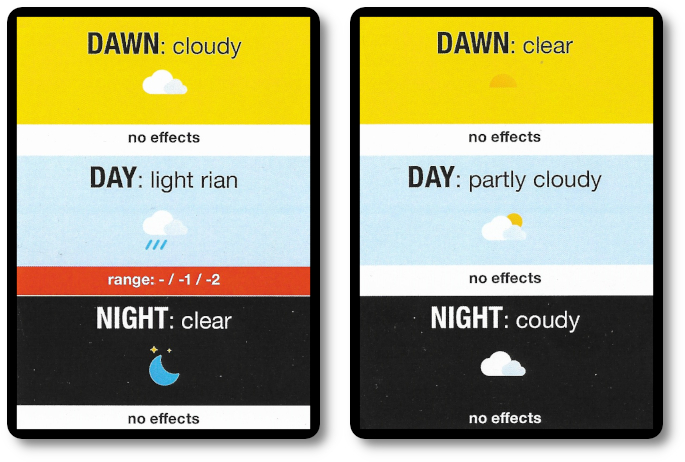
Player actions are broken down into two types. These are “Scout” and “Retreat” moves. Moving about requires the player to consider what loot they want to take with them, sometimes forcing a player to drop loot their character might be holding.
- Scout Moves: This allows the player to investigate a location, which might result in an encounter. If the player’s character encounters nothing, they continue with their day. Otherwise, it’ll require the player to set up the Battlefield (which we describe a bit later).
- Retreat Moves: This allows the player to retreat from battle or retreats to a location (which might trigger a battle).
Reckoning Phase
This is when the player’s character, if they survived, gets a chance to chillout, heal, and eat. Cards are shuffled back into various decks, safe locations become less safe, and food is eaten (which, if the player’s character cannot, introduces a condition referred to as “Starving”).
The food in the game is interesting. Because the infrastructure of the world in less than hygienic, eating introduces the risk of becoming sick. The idea here being you can eat bad food, resulting in a mild case of food poisoning. Not eating at all results in a penalty to rolls until the player’s character has a chance to eat something again.
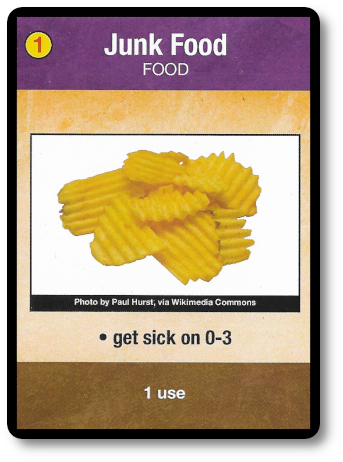
It’s possible that a player’s character must complete their reckoning phase outside, meaning they didn’t make it back to a safe location. Doing so still requires a player to eat something, but because they are not in a safe location, they become sleep deprived. Of course, to counter this condition, a player need only find a cup of coffee (which is what I do every morning, ironically, to make sure I am not a zombie).
Fighting Zombies and Other Nasties
Undead are not the only thing wandering the broken infrastructure that is your neighborhood. Through encounters, players will run into zombies (either shambling, running, or suffering a horrible case of rigor mortise), feral dogs, and living humans who have decided to become somewhat feral themselves. Of course, it’s not all bad in the undead wasteland. Players will encounter (and in many cases, be looking for) allies and various folks dependent on the player character’s survival skills.
If players run into anyone or anything that wants to do their character harm, a battle ensues. Battles are managed using the Battlefield if Scouting during the action phase results in a combat encounter.
The Battlefield is divided into three different zones (using numbers and letters to identify). Walls and starting locations are marked but are considered somewhat “general,” as scenarios can alter the initial placement of pawns (but not to a vast degree).
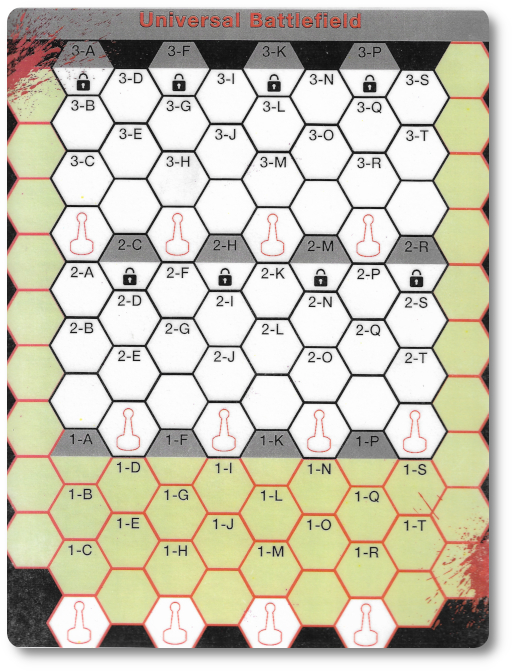
Within each zone, random Encounter cards are placed that seed the action that is to come. Some placement of Encounter cards will create starting placement of enemies at specific locations noted by the Encounter cards. The others will be left face-down and will only be revealed once the player interacts with it. These include rooms with locks and other locations.
Battles are organized into rounds. A player must fight in one round before they can retreat to fight another day. During the round, players will be moving their pawns into various positions to best encounter enemies with what weapons they have (ranged and melee), gather loot, and picking up spent weapons (like arrows), as well as the general movement necessary to tactically shift position.
Combat is managed by rolling dice. The type of weapon used influences the outcome of the dice, as does any conditions the player’s character might be experiencing, in addition to the time of day. Likewise, how many enemies a player takes on is based not only on how they maneuver in the Battlefield, but also if they draw attention to themselves. This is managed using a “Noise” mechanism that determines each round if the player made enough noise to draw attention to themselves.
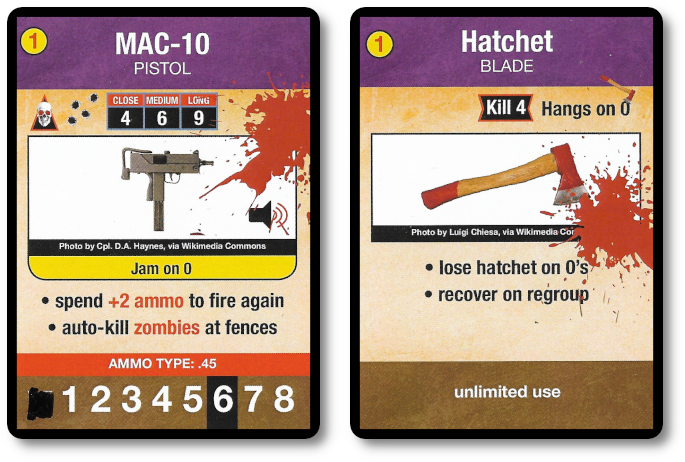
When moving (by either directly engaging, charging, or retreating), and then engaging in combat (using melee or ranged weapons), the player will be busy jumping around the Battlefield and attempting to do damage. All pretty standard stuff. They also complete several free actions that include grabbing loot, reloading, fixing jammed weapons, and recovering lost weapons. When in the Battlefield, the player can drop loot to make room for other loot or brandish a different weapon.
Enemies in the game use simple conditions to determine how they react and move about. For example, zombies and feral dogs move to the closest survivor. If there is a choice to be made, the outcome of that choice is based on a die roll. Human enemies, however, a bit smarter and more random. Cards are used to determine how they move, and if they ever run out of ammo, they make a hasty retreat. This means players can make reasonable assumptions about how their enemy will react, adjusting the distance, and moving tactically to avoid unnecessary combat whenever possible.

Death and Undeath
The world of Card-Z is pretty dangerous. With undead walking around, feral dogs, and other enemies, you should expect your character to be put in harm’s way. Frequently. They can take wounds that, if not correctly managed, could lead to the character’s untimely death. Even the common cold is a condition you want to make sure your characters avoid!
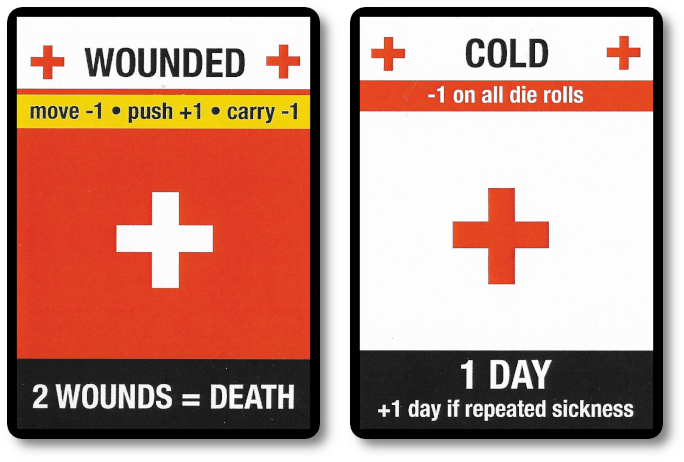
When fighting the undead, you know there will be risks. The main one being bit. If a player’s character is unlucky enough to be bit by a zombie on the Battlefield, they have one round to keep going, but then parish. Yes, the zombie infection in this game is just that bad. No hit points to track here. You are either bit and die or live for another round.
Even worse, and well within the theme of that game (but ultimately an optional rule to adopt if the player wants to), player characters who fall to the infection become a zombie and enter the Battlefield after a few rounds. Terrifying.
Winning the Game
As mentioned, Card-Z is scenario-driven. To win, the players must meet the scenario’s objective. If they do, great! Victory! If not, well, boo. Also, depending on the scenario, players will either win together or be in direct conflict with each other. When going solo, victory comes with a way to measure the greatness of said victory using a rudimentary system that grades the player’s performance.
To learn more about Card-Z and its upcoming Kickstarter, visit the game’s website.
Final Word
 The Child Geeks, who love zombies, really disliked this game. According to one Child Geek, “I never felt like I was playing a game. It felt like work. It felt like I was expected to manage a lot more than just wanting to fight a zombie.” Another Child Geek said, “I know this is a zombie game, and you are not supposed to get bitten, and you need to survive, but I don’t like that I also have to find food to eat. I did like that you can carry toilet paper, though. That was funny.” Card-Z targets audiences over the age of 14-years-old, but I would venture that whoever plays the game – regardless of age – also has a lot of mental stamina. Clocking in at over two hours to complete and the need for a lot of attention to detail to survive, Card-Z killed the Child Geeks’ enthusiasm, not with the undead, but through the sheer demand the game put on them.
The Child Geeks, who love zombies, really disliked this game. According to one Child Geek, “I never felt like I was playing a game. It felt like work. It felt like I was expected to manage a lot more than just wanting to fight a zombie.” Another Child Geek said, “I know this is a zombie game, and you are not supposed to get bitten, and you need to survive, but I don’t like that I also have to find food to eat. I did like that you can carry toilet paper, though. That was funny.” Card-Z targets audiences over the age of 14-years-old, but I would venture that whoever plays the game – regardless of age – also has a lot of mental stamina. Clocking in at over two hours to complete and the need for a lot of attention to detail to survive, Card-Z killed the Child Geeks’ enthusiasm, not with the undead, but through the sheer demand the game put on them.
 The Parent Geeks liked the idea, and many of the little rules that made the game feel deeper than just fighting shambling undead. According to one Parent Geek, “Lots of attention to detail in this game which I like. I don’t feel like I’m playing a game, however. More like I’m testing real-life scenarios on how to survive. Which is interesting and creepy.” Another Parent Geek said, “I like zombie games, but this felt more like work than play. So many little gotchas, and I love the little details the game designer put in. Great stuff for those of us who love zombie games, but I don’t think I would get this game to the table often. The game is just too heavy for my casual player friends and too long to keep the interest of my wife and kids.” When the games were over, and the survivors made it home, it was with a sad heart they put this game to rest with zero chance of it returning from the grave.
The Parent Geeks liked the idea, and many of the little rules that made the game feel deeper than just fighting shambling undead. According to one Parent Geek, “Lots of attention to detail in this game which I like. I don’t feel like I’m playing a game, however. More like I’m testing real-life scenarios on how to survive. Which is interesting and creepy.” Another Parent Geek said, “I like zombie games, but this felt more like work than play. So many little gotchas, and I love the little details the game designer put in. Great stuff for those of us who love zombie games, but I don’t think I would get this game to the table often. The game is just too heavy for my casual player friends and too long to keep the interest of my wife and kids.” When the games were over, and the survivors made it home, it was with a sad heart they put this game to rest with zero chance of it returning from the grave.
 The Gamer Geeks enjoyed the little details and how they translated to rules. They immensely disliked, however, how fiddly the game started to feel as they progressed. According to one Gamer Geek, “The problem the game suffers is one of too much realism. Which I know is funny to say about a game about zombies. Too much to keep track of that feels unimportant and not enough action to make the game feel like you should ever get worried. I spent more time trying to think of ways to get food and when to move in the game, which is great, but put any interest in zombies on hold.” Another Gamer Geek said, “This is truly a game from a gamer who enjoys games. I would love to sit down and play this with the designer. I bet they are crazy passionate about it, and the game would be all the more entertaining as a result. However, when I play it now, it feels like I am playing someone else’s pet project. I don’t think this game was meant for me. I think it was always meant to be shared with me. There is a difference there.” When all the games were over, the Gamer Geeks gave Card-Z a respectful nod for all that it was trying to accomplish, but they didn’t think it bit deep enough to leave a mark.
The Gamer Geeks enjoyed the little details and how they translated to rules. They immensely disliked, however, how fiddly the game started to feel as they progressed. According to one Gamer Geek, “The problem the game suffers is one of too much realism. Which I know is funny to say about a game about zombies. Too much to keep track of that feels unimportant and not enough action to make the game feel like you should ever get worried. I spent more time trying to think of ways to get food and when to move in the game, which is great, but put any interest in zombies on hold.” Another Gamer Geek said, “This is truly a game from a gamer who enjoys games. I would love to sit down and play this with the designer. I bet they are crazy passionate about it, and the game would be all the more entertaining as a result. However, when I play it now, it feels like I am playing someone else’s pet project. I don’t think this game was meant for me. I think it was always meant to be shared with me. There is a difference there.” When all the games were over, the Gamer Geeks gave Card-Z a respectful nod for all that it was trying to accomplish, but they didn’t think it bit deep enough to leave a mark.
 Card-Z is as much a game as it’s a love letter to the Zombie Survival genre popularized in media. Just about everything you can think of that would be of concern or interest to someone experience a genuinely apocalyptic event is provided here. This made the game feel overwhelming to our Child Geeks, too heavy for our Parent Geeks (and casual players), and fiddly to our Gamer Geeks. The game isn’t streamlined for fast play. Instead, it lets the players manage their day to day activities and combat in the game with an eye for detail. It’s this detail; however, that leans too much into the minutiae of any ordinary day. Eating, for example, or picking up ammunition. Yes, it’s something that you would need to act upon, but in a game it’s seldom entertaining to manage to such a finite level.
Card-Z is as much a game as it’s a love letter to the Zombie Survival genre popularized in media. Just about everything you can think of that would be of concern or interest to someone experience a genuinely apocalyptic event is provided here. This made the game feel overwhelming to our Child Geeks, too heavy for our Parent Geeks (and casual players), and fiddly to our Gamer Geeks. The game isn’t streamlined for fast play. Instead, it lets the players manage their day to day activities and combat in the game with an eye for detail. It’s this detail; however, that leans too much into the minutiae of any ordinary day. Eating, for example, or picking up ammunition. Yes, it’s something that you would need to act upon, but in a game it’s seldom entertaining to manage to such a finite level.
That is, of course, unless you are a massive fan of the apocalyptic horror survival games. In which case, Card-Z is going to make you drool. Each scenario has a defined objective that at first blush seems easy. Get into it and venture out through the neighborhood and you’ll come to realize it’s anything but. Death is around every corner, and just a scratch from one of the zombies means the end. Lots to consider, and the amount of time I spent prepping to go a few blocks felt labored, but so worth it when I ran into a bunch of fast zombies. Of course, just the opposite happens, too, and often. Halfway through the scenario, you realize you didn’t plan right. You need to scrounge, and when you do, you put yourself at risk. Tense moments abound.
To make sure we are all clear here, this is a game for the zombie post-apocalyptic survivalist enthusiast. It isn’t going to appeal to a large audience in a general sense. The game can feel punishing and very rewarding. That is going to excite a very select group of gamers who always look for a sense of realism in their gameplay.
For the casual player or gamer looking to take the fight to a zombie horde and kicking some undead butt, Card-Z is going to feel like work. It just isn’t that kind of game. It takes its time to get down into the dirt and make the players think through their moves. If you rush, you are going to fail. Take your time, and you will survive…. maybe. Nothing is promised in the bleak world of Card-Z other than the opportunity to make your own choices, of which there are many.
This is a paid-for review of the game’s final prototype. Although our time and focus were financially compensated, our words are our own. We’d need at least 10 million dollars before we started saying what other people wanted. Such is the statuesque and legendary integrity of Father Geek, which cannot be bought except by those who own their private islands and small countries.



